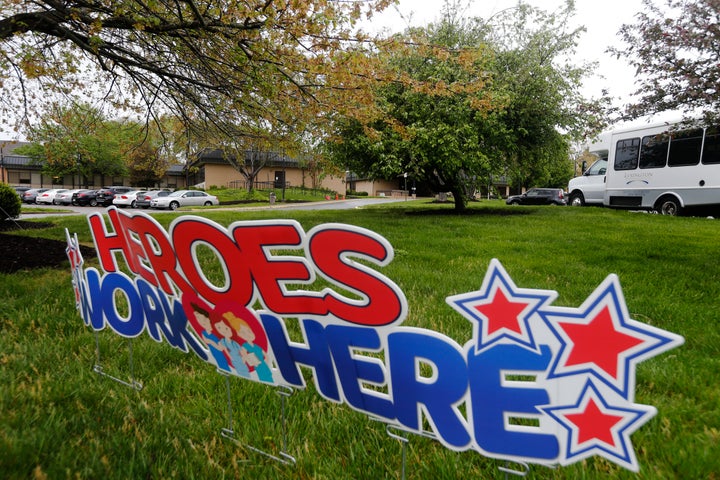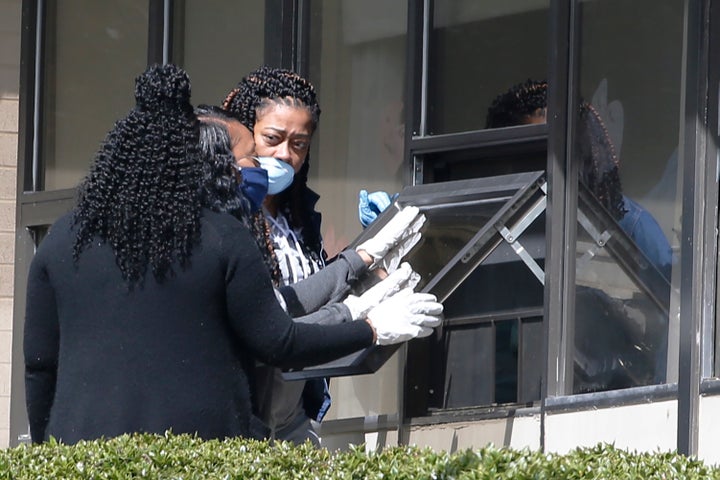RICHMOND, Va. (AP) — Ronald Mitchell worried about his mother’s care at a suburban Richmond nursing home long before she was swept up in one of the nation’s deadliest coronavirus outbreaks.
She’s bedbound and susceptible to seizures. A sore on her foot went unnoticed for so long, he said, that it led to the amputation of her leg. When he called her last month after she tested positive for COVID-19, she sounded disoriented, and he stayed on the line as she pressed a call button and waited an hour and a half for a nurse who never came.
Mitchell then called Canterbury Rehabilitation & Healthcare Center directly and was told that they were doing the best they could with just two nurses looking after 40 patients at a time in the coronavirus quarantine wing.
With the death toll from the Canterbury outbreak rising to 45, Mitchell can only hope that his 62-year-old mother now on a ventilator in a hospital won’t be next.
“It’s the worst feeling in the world,” he said.
Canterbury, which has surpassed the most recent death toll of 43 in the outbreak at the Life Care Center in suburban Seattle, is the kind of facility that’s particularly vulnerable to a coronavirus wildfire that has raged through the nation’s frail, elderly long-term care populations, claiming more than 4,000 lives.

Nearly all of Canterbury’s residents rely on Medicaid funding for care of health problems that in many cases were the product of a lifetime of poverty. It lacks the amenities and space to keep people apart. And it lacks the pay to hire and keep enough staff.
“A publicly funded nursing home is a virus’s dream,” said Dr. Jim Wright, Canterbury’s medical director. “It is the best place for a virus to be. People are close together. Their immune systems are compromised. It is just a tinderbox for that match.”
Studies have shown nursing homes heavily dependent on Medicaid for revenue have fewer nurses and other staff per patient than average and lower quality of care overall. And some off the biggest outbreaks so far have been at homes tied closely to the government payment program, including ones in Wayne, West Virginia, and the Crown Heights section of Brooklyn in New York.
Canterbury, which had about 160 residents before its outbreak, was thrown into turmoil from the first COVID-19 diagnosis on March 18. Many of the staff who work at multiple facilities — Wright couldn’t say exactly how many — quit because they otherwise wouldn’t have been able to continue at their other jobs. Other workers began to get sick themselves.
Around the same time, the second doctor who typically saw patients just stopped showing up, which Wright said had a severe impact on the ability to monitor patients. His wife, a palliative care physician, started volunteering. Everyone at Canterbury had no choice but to take on unfamiliar tasks.
“I was changing patients, cleaning beds. My administrator was delivering meal trays,” Wright said.
“You pick any element, or any arena in our facility that needed to be up and running at its best and nothing was,” he said.

Exactly how the coronavirus got into Canterbury was not clear, though health officials suspect either an infected worker or someone else who came in before visitations and get-togethers were halted in mid-March.
COVID-19 tests were available but scarce at the beginning of the outbreak, but Canterbury was not initially able to test all of its residents and staff because of guidance from state and national officials at the time. Virginia’s rules said even long-term care residents had to first be tested to rule out the flu and other respiratory pathogens, something Wright and other medical directors asked the health department to change because of the delay it created.
By the time tests were finally conducted on everyone at Canterbury about two weeks after the first confirmed case, more than half the residents infected with coronavirus — 53 out of 92 — showed no symptoms of the disease.
“It’s impossible to build walls around something that spreads so insidiously,” said Dr. Danny Avula, the state health department’s area director who has noted that Canterbury has been doing its best.
Even in normal times, Canterbury merited just one out of five stars in Medicare’s rating system, with inspection records showing the facility had such poor staffing levels that it impacted patient care.
One nurse told an inspector last year “residents would stay in bed because it is almost impossible for two people to assist 62 or 63 residents.” Previous inspections also found infection-control problems and failure to report an attempted rape of a patient.
Relatives of Canterbury residents described a facility with long-running quality-of-care problems and said they thought more could have been done to prevent the spread. They also said they had not received adequate communication during the crisis.
Kim Thompson’s phone rang before 6 a.m. Thursday, and when Wright told her that her 72-year-old mother, Minnie Brown, had died, she thought it had to be a mistake.
Thompson had spoken with her mother over FaceTime two days earlier and she seemed in good health and spirits. Since that phone call, the family had received no updates from Canterbury letting them know her condition had deteriorated.
“It’s neglect. It’s negligence,” Thompson said in an interview.

Thompson said as Canterbury’s death toll began to climb, she started researching the response at the Life Care Center outbreak near Seattle, where a special federal group of doctors and nurses was sent to help.
Since then, several governors have used their emergency power to do the same for their homes. The National Guard was called in to evacuate a home in Tennessee, take over another one in Massachusetts and run tests at a third in Wisconsin. And special “strike teams” have been tapped to run tests and ferry supplies to homes in Ohio, Indiana and Maryland.
“Where is the state in some of this? Why wasn’t more done on a state level as well to come in and take over the situation?” Thompson asked, noting that at one point the victims from Canterbury accounted for about a third of the state’s dead. “There’s lots of blame to go around.”
Virginia Gov. Ralph Northam recently proposed a budget amendment that increases the rates paid to nursing homes and long-term care facilities by an additional $20 for Medicaid recipients per day. He’s also announced the creation of a task force that is working with such facilities to try and cut the infection rates and deaths.
“This boost in funding will help these facilities address staffing issues during this epidemic,” Northam said.
Wright, who continues to care for the Canterbury patients who remain, was asked in a news conference last week if he would have done anything differently.
“I would have a nursing home that had enough staff around-the-clock, around all the time. I would have a nursing home where everyone had private rooms. I would have a nursing home where there was greater access to the outdoors,” he said.
“In other words, I would have a nursing home funded by a society that puts more emphasis on treating our elders the way they should be treated.”
Condon reported from New York. Investigative news researcher Randy Herschaft in New York contributed to this report.
A HuffPost Guide To Coronavirus
Calling all HuffPost superfans!
Sign up for membership to become a founding member and help shape HuffPost’s next chapter
Credit: Source link